Themed collection Bioanalytical sensors for real world applications

Introduction to bioanalytical sensors for real-world applications
Charles Mace, Aoife Morrin and Rebecca Whelan introduce this Analytical Methods themed issue on bioanalytical sensors for real-world applications.

Anal. Methods, 2021,13, 1776-1777
https://doi.org/10.1039/D1AY90015C
From the beaker to the body: translational challenges for electrochemical, aptamer-based sensors
The ultimate goal of implantable electrochemical, aptamer-based (E-AB) sensors is to enable the continuous and precise monitoring of clinically and physiologically important targets in the body for prolonged periods.

Anal. Methods, 2020,12, 1288-1310
https://doi.org/10.1039/D0AY00026D
A flexible and highly sensitive nitrite sensor enabled by interconnected 3D porous polyaniline/carbon nanotube conductive hydrogels
A flexible and highly sensitive nitrite sensor based on PANI–CNT hydrogels.

Anal. Methods, 2020,12, 604-610
https://doi.org/10.1039/C9AY02442E
Optimization of paper-based nanoparticle immunoassays for direct detection of the bacterial pathogen V. parahaemolyticus in oyster hemolymph
The detection of foodborne pathogens is critical for disease control and infection prevention, especially in seafood consumed raw or undercooked.
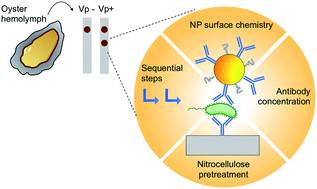
Anal. Methods, 2020,12, 3056-3063
https://doi.org/10.1039/D0AY00725K
Optimization of graphene oxide-modified carbon-fiber microelectrode for dopamine detection
Graphene oxide increases the sensitivity of carbon electrodes, facilitating dopamine detection in brain slices.

Anal. Methods, 2020,12, 2893-2902
https://doi.org/10.1039/D0AY00310G
Electrochemical detection of bovine immunoglobulins G to determine passive transfer of antibodies to calves
Bovine antibodies cannot pass the placental barrier and must be absorbed from colostrum postpartum. Monitoring of IgG absorption in calves is critical in the first 12 hours of life. Novel sensors are presented to measure this transfer process on-farm.
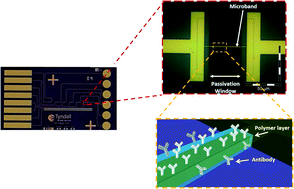
Anal. Methods, 2020,12, 2655-2660
https://doi.org/10.1039/D0AY00194E
A high-throughput plasmonic tongue using an aggregation assay and nonspecific interactions: classification of taste profiles in maple syrup
A simple colorimetric test detects off-flavour profiles of maple syrups in minutes, which are detectable by the naked eye.
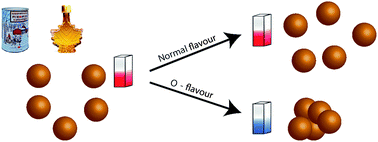
Anal. Methods, 2020,12, 2460-2468
https://doi.org/10.1039/C9AY01942A
Development and validation of a real-time microelectrochemical sensor for clinical monitoring of tissue oxygenation/perfusion
Oxygen is critically important to tissue viability and there is increasing demand for its reliable real-time clinical monitoring in order to prevent, diagnose and treat several pathological disorders, including hypoxia, stroke and reperfusion injury.
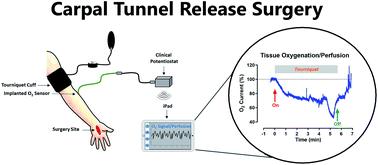
Anal. Methods, 2020,12, 2453-2459
https://doi.org/10.1039/D0AY00206B
Development of a paper-immobilized yeast biosensor for the detection of physiological concentrations of doxycycline in technology-limited settings
To combat pharmaceutical counterfeiting in low- and middle-income countries (LMIC), there is a need for improved low-cost, portable methods that monitor pharmaceutical concentrations relevant to dosage forms and physiological fluids.
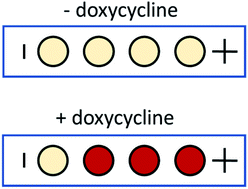
Anal. Methods, 2020,12, 2123-2132
https://doi.org/10.1039/D0AY00001A
Towards simultaneous quantification of protease inhibitors and inflammatory biomarkers in serum for people living with HIV
Detecting small and big molecules together: simultaneous quantification of protease inhibitor (DRV) and inflammatory biomarker in serum by Arrayed Imaging Reflectometry (AIR).
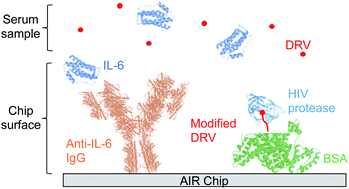
Anal. Methods, 2020,12, 1882-1888
https://doi.org/10.1039/D0AY00098A
Facile fluorescence strategy for sensitive detection of microcystin-LR based on dsDNA-templated copper nanoclusters
We developed a simple, sensitive, low-cost and label-free method to detect microcystin-leucine-arginine (MC-LR) using double-strand DNA-templated copper nanoclusters (dsDNA-CuNCs) as fluorescent probes.
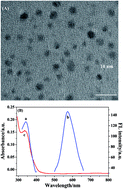
Anal. Methods, 2020,12, 1752-1758
https://doi.org/10.1039/C9AY02250C
Optical nanosensors for in vivo physiological chloride detection for monitoring cystic fibrosis treatment
Endogenous chloride fluctuations were successfully monitored in real-time using optode-based nanosensors during pharmacological treatment in a cystic fibrosis mouse model.
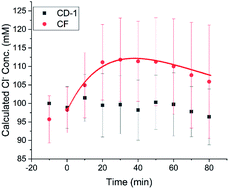
Anal. Methods, 2020,12, 1441-1448
https://doi.org/10.1039/C9AY02717C
A multicolor multiplex lateral flow assay for high-sensitivity analyte detection using persistent luminescent nanophosphors
Multicolor multiplex lateral flow assay using persistent luminescent nanophosphors as reporters.
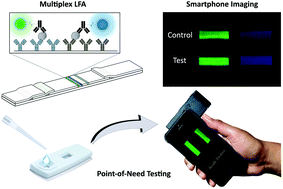
Anal. Methods, 2020,12, 272-280
https://doi.org/10.1039/C9AY02247C
In situ hemolysis in a three-dimensional paper-based device for quantification of intraerythrocytic analytes
Quantitative in situ hemolysis is achieved for samples of whole blood using a chemical treatment without additional user-steps or sample preparation.
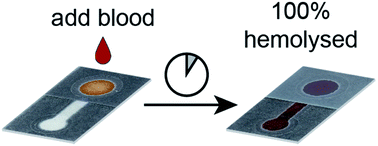
Anal. Methods, 2020,12, 281-287
https://doi.org/10.1039/C9AY02292A
Generating linear oxygen gradients across 3D cell cultures with block-layered oxygen controlled chips (BLOCCs)
BLOCCs are readily assembled structures of laser cut acrylic and silicone, capable of imposing physiologically relevant oxygen gradients across 3D cell cultures. With sensors and cell-based readouts, we quantified cell-microenvironment relationships.
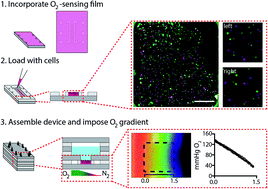
Anal. Methods, 2020,12, 18-24
https://doi.org/10.1039/C9AY01690B
Lactate monitoring in droplet microfluidics: a cautionary tale in assay miniaturisation
We present the development of a droplet-based device for real-time continuous lactate measurement, highlighting how protocols from established homogeneous enzymatic assays require careful re-optimisation before transferring to microfluidic systems.
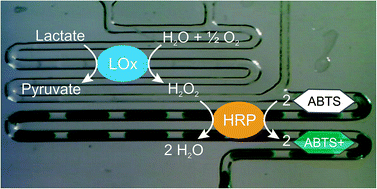
Anal. Methods, 2019,11, 6119-6123
https://doi.org/10.1039/C9AY02070E
Lab on paper: assay of beta-lactam pharmaceuticals by redox titration
This paper test card can identify ampicillin or amoxicillin formulations that contain <90% of the stated API content.
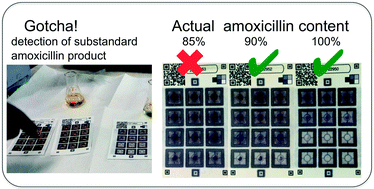
Anal. Methods, 2019,11, 4741-4750
https://doi.org/10.1039/C9AY01547G
Detection of degraded, adulterated, and falsified ceftriaxone using paper analytical devices
A paper test card can distinguish good quality ceftriaxone from ceftriaxone that has been thermally degraded, adulterated, or falsified.
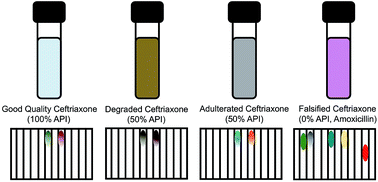
Anal. Methods, 2019,11, 4727-4732
https://doi.org/10.1039/C9AY01489F
About this collection
A collection of papers and reviews in which sensors have been used to measure analytes in complex matrices, using robust technologies and with high sensitivity and specificity. The scope of this collection covers a broad range of applications (both biomedical and environmental) and includes work which describes challenges in sensing of complex analytes or sensing analytes in complex matrices and how these challenges have been overcome.
The collection is Guest Edited by Charles Mace (Tufts University, USA), Aoife Morrin (Dublin City University, Ireland) and Rebecca Whelan (University of Notre Dame, USA).